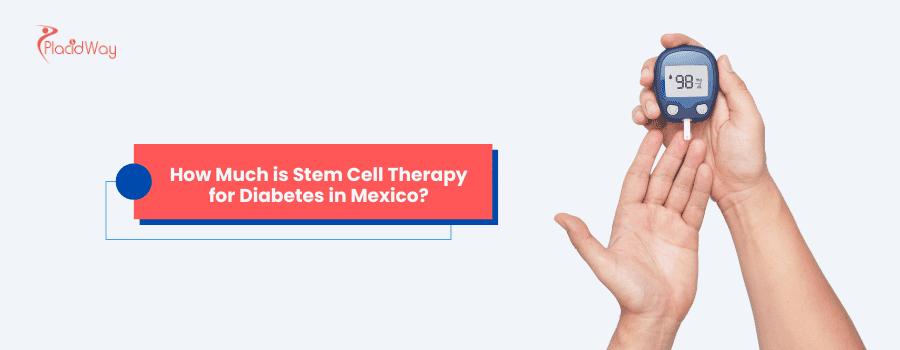Explore the Cost of Stem Cell Therapy for Diabetes in Mexico

Considering stem cell therapy for diabetes in Mexico? You're not alone. This innovative treatment is gaining attention for its potential to manage diabetes, and Mexico has become a popular destination for those seeking affordable and accessible options. If you're wondering about the cost and what the procedure entails, you've come to the right place. This blog post will answer all the important questions you have about stem cell therapy for diabetes in Mexico, providing clear, concise answers and detailed explanations to guide your decision-making process.
The cost of stem cell therapy for diabetes in Mexico can range from approximately $7,000 to over $12,000 USD. This variation depends on the type of diabetes, the clinic's reputation, the specific treatment protocol, and what's included in the package. Many individuals are exploring this option due to the potential for a better quality of life and the significantly lower costs compared to other countries. In this comprehensive guide, we'll break down everything you need to know.
What is the average cost of stem cell therapy for diabetes in Mexico?
"The average cost of stem cell therapy for diabetes in Mexico typically falls between $7,000 and $12,000 USD."
This price range is an estimate and can fluctuate based on several factors. For instance, the number of stem cells required, the method of administration, and the duration of your stay can all impact the final cost. It's crucial to get a detailed quote from your chosen clinic that outlines all included services to avoid any surprises.
Some clinics offer all-inclusive packages that cover the treatment, accommodation, and sometimes even local transportation. These packages can provide a clearer picture of the total investment required. Always inquire about what is specifically covered in the quoted price to make an informed financial decision.
Is there a difference in cost for Type 1 and Type 2 diabetes?
"Yes, the cost can differ. Treatment for Type 1 diabetes may sometimes be more intensive and, therefore, slightly more expensive than for Type 2 diabetes, though this varies by clinic."
The underlying mechanisms of Type 1 and Type 2 diabetes are different, which can influence the treatment approach. Type 1 diabetes is an autoimmune condition where the body attacks its own insulin-producing cells. Stem cell therapy for Type 1 often focuses on modulating the immune system and potentially regenerating these cells.
For Type 2 diabetes, the focus is often on improving insulin sensitivity and overall metabolic function. The treatment protocol might be less complex, potentially leading to a lower cost. However, the severity of the condition and the presence of any complications will also play a significant role in determining the final price for either type.
What does the price of stem cell therapy for diabetes in Mexico typically include?
"Most reputable stem cell clinics in Mexico include the stem cell treatment itself, a medical consultation, and basic laboratory tests in the initial cost. Some may also include accommodation and airport transfers."
It is essential to verify exactly what is included in the treatment package. A comprehensive package might cover:
- The stem cell product and its administration
- Physician consultations and follow-up appointments
- Pre-treatment medical evaluations and lab work
- Medications administered during the treatment
- Hotel stays for a specified period
- Airport pickup and drop-off
Always request a detailed breakdown of costs. This transparency is a hallmark of a trustworthy clinic and will help you budget effectively for your medical journey.
How do the costs in Mexico compare to the US and other countries?
"The cost of stem cell therapy for diabetes in Mexico is significantly lower, often 50-70% less than what you would pay in the United States or Europe."
The primary reason for this cost difference is the lower overhead and operational costs in Mexico. This includes everything from clinic maintenance to staff salaries. Importantly, the lower price does not necessarily mean a compromise on quality. Many top clinics in Mexico are equipped with state-of-the-art technology and staffed by experienced medical professionals.
This substantial cost saving makes Mexico an attractive option for many international patients. It allows individuals to access innovative treatments that might be financially out of reach in their home countries.
What kind of stem cells are used to treat diabetes in Mexico?
"The most common types of stem cells used for diabetes treatment in Mexico are mesenchymal stem cells (MSCs), often sourced from umbilical cord tissue or adipose (fat) tissue."
Mesenchymal stem cells are popular because of their regenerative and anti-inflammatory properties. They have the potential to help repair damaged tissues and modulate the immune system, which is particularly beneficial for both Type 1 and Type 2 diabetes. Umbilical cord-derived MSCs are often preferred as they are young, vibrant, and do not require an invasive harvesting procedure from the patient.
These cells are processed in specialized laboratories to ensure their viability and purity before being administered to the patient. The type and source of stem cells are critical factors in the potential effectiveness of the treatment.
Is stem cell therapy for diabetes in Mexico safe?
"When performed at a reputable and certified clinic, stem cell therapy for diabetes in Mexico is generally considered safe. Look for clinics that adhere to international standards and have positive patient reviews."
Safety is a paramount concern. To ensure a safe experience, it's vital to research and choose a clinic that is licensed by the Mexican regulatory body, COFEPRIS (the Federal Commission for the Protection against Sanitary Risk). Reputable clinics will be transparent about their protocols, the source of their stem cells, and the qualifications of their medical team.
Potential risks, as with any medical procedure, can include infection or a reaction at the injection site. However, these are minimized when treatment is administered in a sterile environment by qualified professionals. Always discuss the potential risks and benefits with the clinic's medical staff.
What is the success rate of stem cell therapy for diabetes in Mexico?
"The success rate of stem cell therapy for diabetes in Mexico can be promising, with many patients reporting improved blood sugar control, reduced need for insulin, and an overall better quality of life. However, results can vary."
It's important to have realistic expectations. Stem cell therapy is not a guaranteed cure for diabetes, but it can lead to significant improvements. Many patients experience a reduction in their HbA1c levels, decreased dependency on diabetes medications, and a lower risk of long-term complications.
The success of the therapy depends on various factors, including the patient's overall health, the type and severity of their diabetes, and their lifestyle choices post-treatment. Reputable clinics will often share anonymized patient testimonials and data on their outcomes.
What is the process of getting stem cell therapy for diabetes in Mexico?
"The process typically involves an initial consultation, pre-treatment evaluation, the stem cell administration itself, and a period of recovery and follow-up."
The journey usually begins with an online or phone consultation where you discuss your medical history with the clinic's specialists. If you are a good candidate, you will travel to the clinic in Mexico. Upon arrival, you'll undergo a thorough medical evaluation, including blood tests.
The stem cells are usually administered intravenously (IV drip). The procedure itself is minimally invasive and relatively quick. After the treatment, there is typically a short recovery period at the clinic or a nearby hotel before you are cleared to travel back home.
How long does the treatment take?
"The stem cell administration itself is usually completed in one to a few hours. However, the entire trip to Mexico for treatment typically lasts from a few days to a week."
This timeframe allows for the initial consultation, pre-treatment tests, the procedure, and a short observation period to ensure there are no immediate adverse reactions. The extended stay also provides an opportunity to relax and recover in a comfortable environment before your journey home.
Can stem cell therapy cure diabetes permanently?
"Currently, stem cell therapy is not considered a permanent cure for diabetes. However, it has the potential to induce long-term remission and significantly reduce symptoms and the need for medication."
The goal of stem cell therapy for diabetes is to manage the condition more effectively and improve the patient's quality of life. While some patients have experienced prolonged periods of insulin independence, it is not yet a universally permanent solution.
Ongoing research continues to explore the long-term effects and potential for a lasting cure. For now, it is best viewed as a powerful tool for managing diabetes and its complications.
Are there payment plans available for the treatment?
"Yes, many clinics in Mexico that cater to international patients offer or can connect you with third-party financing options and payment plans to make the treatment more affordable."
Understanding that the upfront cost can be a barrier for some, many clinics have established relationships with medical financing companies. These companies can offer loans with flexible repayment terms. It's always worth inquiring about these options during your initial consultation.
What are the legal regulations for stem cell therapy in Mexico?
"Stem cell therapy in Mexico is regulated by COFEPRIS. It is legal to receive stem cell treatments in Mexico, provided the clinic is licensed and follows the established guidelines."
COFEPRIS is responsible for ensuring the safety and efficacy of medical treatments, including stem cell therapy. When choosing a clinic, verifying their COFEPRIS certification is a crucial step in ensuring you receive treatment that meets regulatory standards. This provides a layer of protection and assurance for international patients.
Ready to explore your options for stem cell therapy for diabetes in Mexico? PlacidWay can help you connect with reputable clinics and find a solution that fits your needs and budget. Explore our network of trusted healthcare providers today.


.png)





.jpg)
.png)







Share this listing